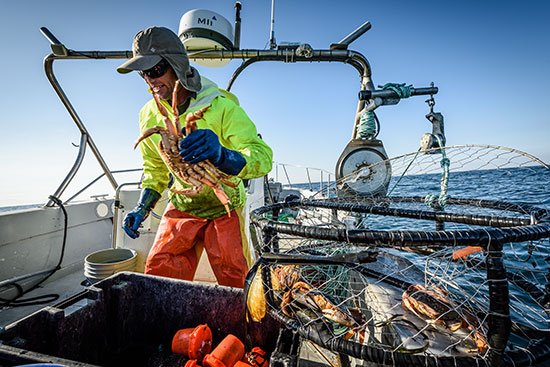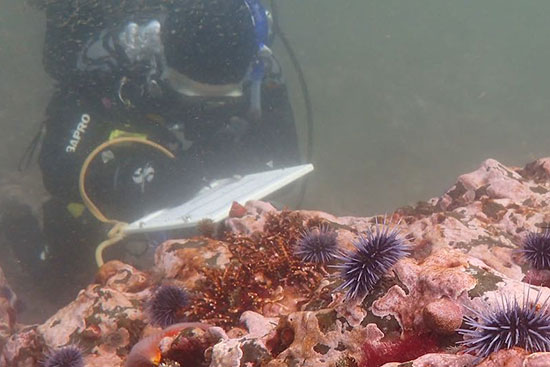The Marine Life Management Act (MLMA) is California’s primary fisheries management law. It directs the California Department of Fish and Wildlife (Department) to develop a Master Plan to guide its implementation. The original Master Plan, adopted in 2001, is being updated to reflect new priorities and emerging management strategies for achieving the MLMA’s goals, and to better describe the Department’s inclusion of MLMA principles in management decisions. The 2018 Master Plan (Master Plan) replaces the original and is re-structured to better meet the specific management objectives identified in the MLMA. It is intended to be both a roadmap and a toolbox for implementation, providing guidance and direction in the following areas.
Prioritization of management efforts
The Master Plan includes an interim list of prioritized species for management action based on the results of a Productivity and Susceptibility Analysis (PSA)(opens in new tab). It also describes a more comprehensive approach to prioritization within a framework for MLMA-based management (framework) that includes an assessment of the risks fishing poses to a given stock(opens in new tab) and to the ecosystem(opens in new tab), the extent to which current management is addressing those risks, and the socioeconomic and community opportunities. The goal is to allow the Department to focus limited management resources on the fisheries with the greatest need and opportunities for resource and ecosystem benefits to the state of California.
Meeting stock sustainability objectives
The MLMA identifies the sustainability of fish stocks and the fisheries that depend on them as its primary fishery(opens in new tab) management goal as stated in Fish and Game Code Section (§) 7056(opens in new tab). There are new tools and approaches available to help consider and identify the most appropriate management strategies for achieving sustainability. Even when limited information is available, it is possible to be explicit about potential benefits and costs of different management strategies. The Master Plan identifies some of these approaches and provides guidance regarding their use.
 Fishing for crab off the California coast. (© David Hills, all rights reserved)
Fishing for crab off the California coast. (© David Hills, all rights reserved)
Meeting ecosystem objectives
The MLMA also emphasizes the importance of conserving the health of marine ecosystems (§7050(b)(1)(opens in new tab)), and specifically, the need to consider impacts to habitat and bycatch species when prioritizing and managing fisheries (§7056(b)(opens in new tab) and §7085(opens in new tab)). The Master Plan provides a step-wise approach to consider and address these issues.
Integrating Marine Protected Areas into fisheries management
California has an extensive network of Marine Protected Areas (MPAs)(opens in new tab) that affect fisheries management and stakeholders(opens in new tab). Accounting for these MPAs when considering how to meet stock and ecosystem-related objectives is a key aspect of MLMA implementation. If successful, integration of the MPA network into fisheries management is expected to provide significant benefits to fisheries and resources alike.
Adapting to climate change
The effects of climate change can pose challenges to fisheries management and underscore the need for adaptive and responsive management that can adjust to changing species distribution and abundance, habitat alteration, and impacts to port infrastructure. Targeted research, consideration of multiple indicators(opens in new tab), and collaborations with stakeholders can help to make management better able to adapt to these shifts. Climate change considerations factor into species prioritization, scaled management, identification of appropriate management strategies, adaptive management(opens in new tab) structures, and understanding the effects of management on fishery economics and communities.
 A fisherman in California. (© David Hills, all rights reserved)
A fisherman in California. (© David Hills, all rights reserved)
Engaging stakeholders
Engaging the public in management, research, and decision-making is a central tenet of the MLMA. Ensuring that engagement is meaningful, cost-effective, and leads to well-supported management requires strategies for tailoring efforts to the needs of specific situations. The Master Plan provides guidance on considering and crafting potential engagements.
Collaborating with partners
California is home to a diverse suite of academic and research institutions, Tribes and tribal communities, engaged stakeholders, cooperating agencies, and a range of supplemental public and private funding sources. Well-designed collaborations can be an important means of increasing the Department’s limited capacity(opens in new tab) and allowing for enhanced management. The Master Plan seeks to identify a range of areas where collaboration may be beneficial and the conditions necessary to ensure collaborations can achieve their objectives.
 Monterey Bay. (© David Hills, all rights reserved)
Monterey Bay. (© David Hills, all rights reserved)
Advancing socioeconomic and community objectives
The MLMA has sustainability as its primary goal, but it also seeks to promote healthy fisheries (§7056§7056(opens in new tab)). Understanding the range of stakeholders’ economic and community interests is critical to identifying opportunities to enhance profitability during prioritization and create management measures that have the support of those affected. The Master Plan describes key socioeconomic questions and identifies strategies for obtaining related information as part of Master Plan implementation.
Making management adaptive
The ocean is a highly variable environment and climate change may amplify that variability. Adaptive management can help to ensure that harvest strategies reflect current population levels and ocean conditions and are able to effectively respond to future changes to the fishery or resources. Targeted data collection, strategically selected indicators, and responsive decision frameworks can help management be as adaptive and flexible as possible. The Master Plan identifies a range of structures, strategies, and recommendations for meeting the adaptive management objectives of the MLMA.
 A CDFW diver collecting data on urchins. (CDFW photo by Cynthia Catton)
A CDFW diver collecting data on urchins. (CDFW photo by Cynthia Catton)
Using the best available scientific information
The MLMA stipulates that decisions shall be based on the best available scientific information and other relevant information (§7050(b)(6)(opens in new tab) and §7056(g)(opens in new tab)) and places significant emphasis on the role of scientific peer review in the development of Fishery Management Plans (FMPs)(opens in new tab), research protocols, and other documents that have a scientific basis (§7062(a)(opens in new tab)). The appropriate scope, scale, and timing of scientific peer review, however, needs clarification and guidance to ensure that it is carried out in a consistent way. The Master Plan identifies tiers of potential review and considerations for identifying when each may be appropriate.
Enhancing and scaling Marine Life Management Act-based management
The state’s fisheries vary dramatically in terms of their complexity, geographic scope, value, level of participation, and management needs. A comprehensive and complex FMP may not be appropriate for all fisheries. The ability to scale management efforts to the needs and characteristics of a specific fishery is critical to optimizing the use of management resources. While FMPs remain an important tool for achieving the objectives of the MLMA, other tools such as Enhanced Status Reports (ESRs)(opens in new tab), targeted rulemakings(opens in new tab), and more streamlined FMPs can also be used. The Master Plan describes a continuum of management intensity and identifies criteria for determining where a given fishery may fall along the continuum. The goal is to make more efficient and effective use of available tools and resources to implement the MLMA across a wider range of California’s fisheries.
Ensuring the Master Plan is an effective resource and guide
The MLMA emphasizes the need for transparency in management and the importance of communicating management decisions and the condition of fisheries to the public (§7056(h)(opens in new tab)). However, planning documents like the Master Plan can become outdated over time. The Master Plan describes the use of a new, online, publicly-accessible and user-friendly “living” library for California’s state-managed fisheries information and the policies and tools of the Master Plan called the California Fisheries Portal(opens in new tab). The goal is to organize and share the considerable research and management efforts of the Department and its partners, provide management resources and tools, and implement the new strategies described in the Master Plan.